
I got this issue of AVENGERS from my comic book reading pal Donald Sims, the first person I knew besides myself who really cared about comic books (and who made his own, just as I did.) He’d gotten a stack of cast-off comics from some relative who had outgrown them, so he had all sorts of books that dated back to just before I started reading comics. I can recall reading FOREVER PEOPLE #1 and MISTER MIRACLE #2 at his house, and he once loaned me the full run of SHAZAM. This cover always bothered me a little bit as a kid for how off-model Klaw’s face is here.

The art on this particular issue was a bit of a step up from others that I had read thanks to the addition of the polished inking of Dave Cockrum embellishing Bob Brown’s solid pencils. Cockrum was one of the true greats of the era, even though his output was never quite fast enough to give him a sustained run on any regular series. (On X-MEN, he had the advantage of the series being bimonthly; it wouldn’t switch over to monthly production until John Byrne came on board.) He inked a series of AVENGERS issues around this time, in every case making them look better and more stylish than the ones around them.
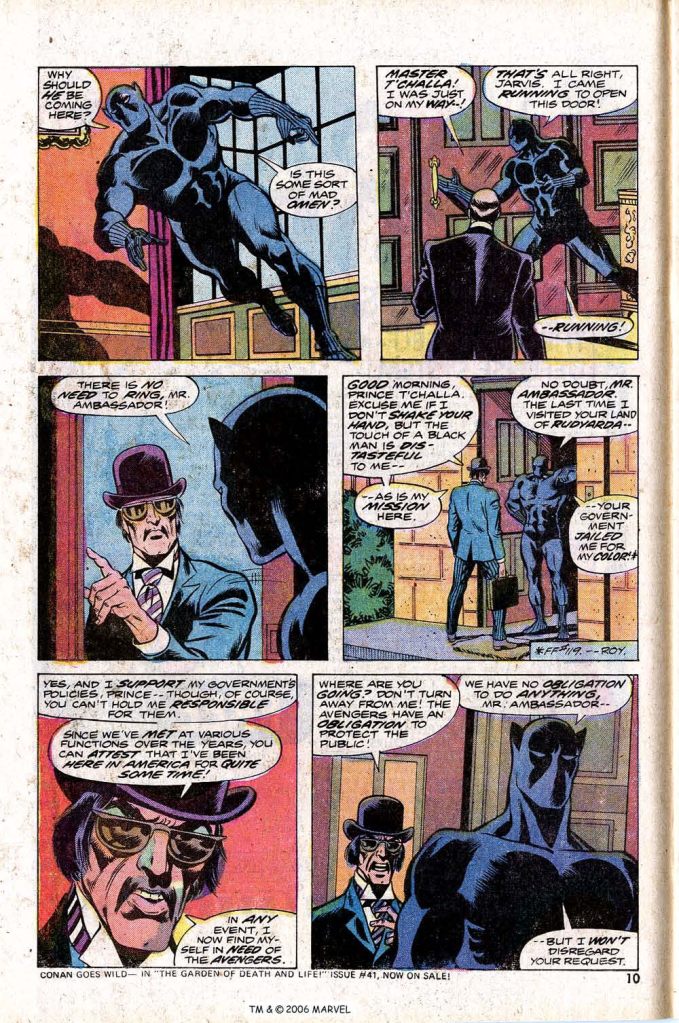
This issue was smack-dab in the middle of Steve Englehart’s long run as writer of the series, and so there were a number of subplots running throughout the issue. But it helped that the main story was a stand-along single issue story in terms of my comprehension. Additionally, Englehart was simultaneously trying to thread the needle of continuity between this book and his other title CAPTAIN AMERICA. In that series, Cap had decided to give up his costumed identity in the aftermath on the revelation of Number One of the Secret Empire’s true identity (spoiler: he was President Richard Nixon.) So for most of the first half of the issue, events swing back and forth between setting out the romantic rectangle between the Swordsman, Mantis, the Vision and the Scarlet Witch and Thor and Iron Man attempting to convince Cap not to pack things in.
Elsewhere, the Black panther is wrestling with his own dilemma: he loves being an Avenger and active on teh world stage. And yet, his countrymen in far-off Wakanda need him as well. As he contemplates his life choices, T’Challa’s reverie is shattered by a visitor at the Avengers’ front door. This turns out to be the Ambassador of Rudyarda, a white supremacist country which had appeared in an earlier FANTASTIC FOUR story that the Panther had appeared in. Despite the ambassador’s distaste for the Panther (and for the Vision as well once he arrives, him being a red-skinned android) he’s here seeking the Avengers’ help. The Embassy staff have all been threatened, and one has been killed by a mystery assailant. The Avengers set out to investigate, but before they can get far, they find themselves trapped within a dome of solidified sound, courtesy of Klaw, who appears as a colossal image. He’s thrown in with Solarr, another villain, and they’re intending to hold the ambassador and the Avengers hostage in exchange for making Klaw the dictator of Wakanda. Cockrum does an especially great job on this double-page spread, which was one of those cost-saving measures that was in effect in the early 1970s, where a single page would be turned on its side and run as a spread. Unlike many of them, this one actually holds up well despite the difference in reduction.
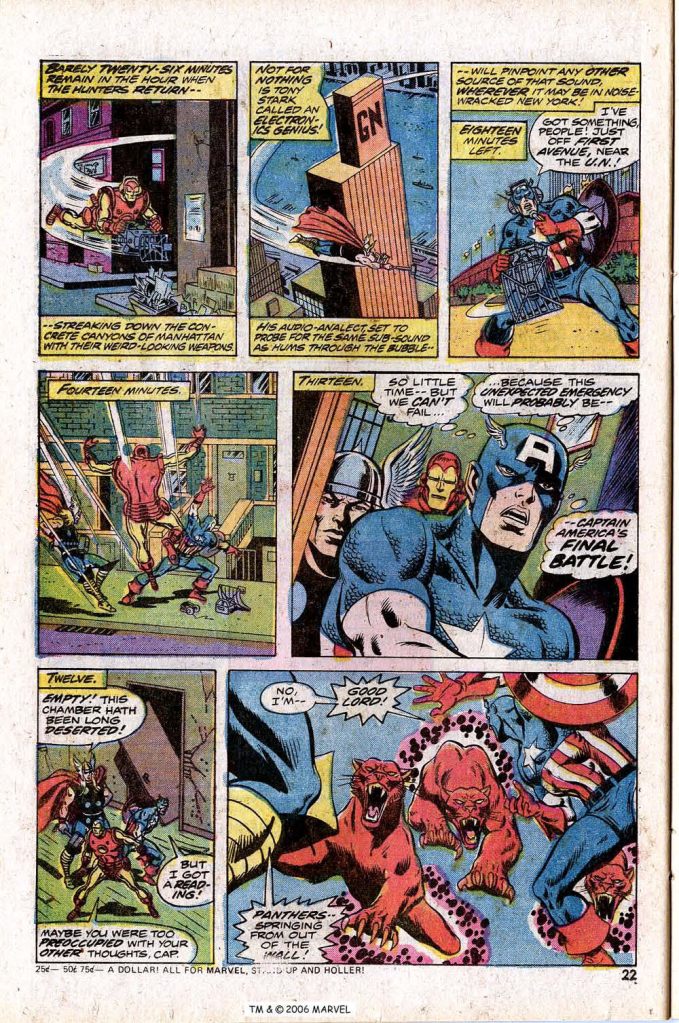
The Avengers Big Three of Thor, Captain America and Iron Man are still outside of the dome, but nothing they do can pierce it–nor can the Avengers trapped within liberate themselves. Klaw and Solarr give the Panther one hour to hand over the keys to his kingdom before Solarr blasts one of the hostages to smithereens with his sun-powers. T’Challa realizes that Klaw needs to be within a certain radius in order to be maintaining the solid-sound shell that encases the victims, and so the liberated Avengers embark on a hasty search. Along the way, they get to tussle with a number of vicious animals made of solidified sound so that there’ll be some action in the story. But the real emotional action is inside the dome, as Wanda confronts the Vision about his feelings for Mantis. It’s been so long now that most fans of today don’t recall when AVENGERS was home to the kind of soap opera that helped put X-MEN on the map, but here it plays out beautifully in Englehart’s hands. Wanda is emotional, the Vision is stoic, and their conversation feels both frustrating and real as they don’t quite communicate on the same wavelength.
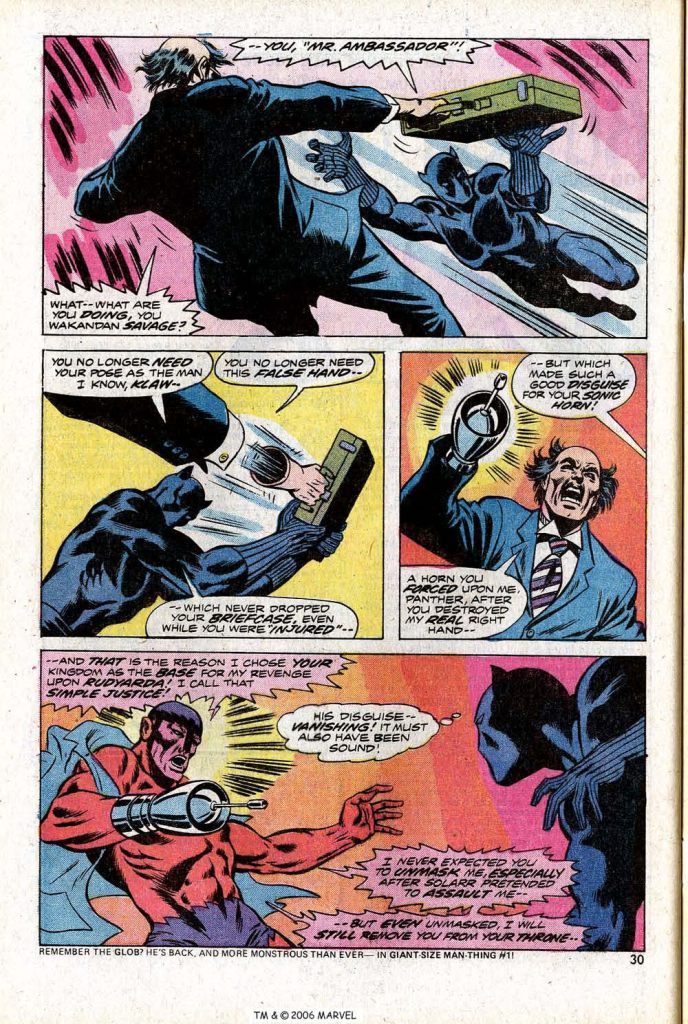
But no sign of Klaw can be found, and the minutes tick down to the death of one of those imprisoned. considering the situation closely, the Panther lunges at the Rudyardian ambassador. Earlier, Solarr had struck the man down, and he was only saved by the intervention of the Scarlet Witch. But all throughout that encounter, he never lost his grip on his briefcase. And that’s because his right hand is a lifeless prosthetic, designed to conceal the sonic horn Klaw wears in place of his lost hand. He’s been posing as the ambassador the whole time, and right in the midst of his captives. But this reveal makes the Panther the immediate target of both the Master of Sound and his accomplice in the dome above.
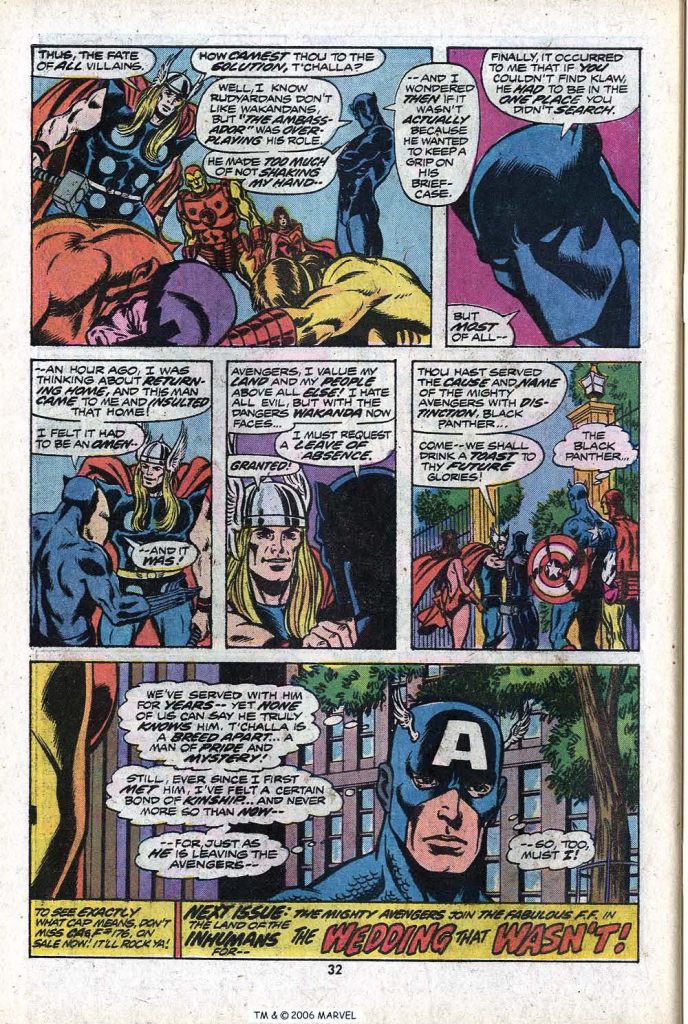
But T’Challa is up to the challenge. He’s able to dodge the strikes of both his foes until he can knock Klaw senseless and destroy the briefcase, which contains the equipment Klaw has been using to maintain the dome. The dome falls–and so does Solarr as his perch suddenly disappears. And so the Avengers are triumphant. But this experience has crystalized the Panther’s thoughts about returning to his homeland, and he requests a leave of absence from the Avengers (this was no doubt prompted on Englehart’s part by the inauguration of Don McGregor’s Black Panther series appearing in JUNGLE ACTION, which was entirely set in Wakanda.) And as the Avengers head inside to toast their departing comrade, we hone in on Captain America’s thoughts–and he confirms for the readers that he’s about to do the very same thing.

And the letters page in this particular issue contained a letter from future Marvel editor and writer Ralph Macchio. he was a well-known fan of what Englehart was doing in the book, and was thus a frequent letter-writer to its pages. It also included that issue’s Marvel Value Stamp, a strange little promotion that ran for years and resulted in the defacing of hundreds of back issues–buying a book from this period only to discover that the Value Stamp had been cut out of it is a rite of passage on collecting circles.

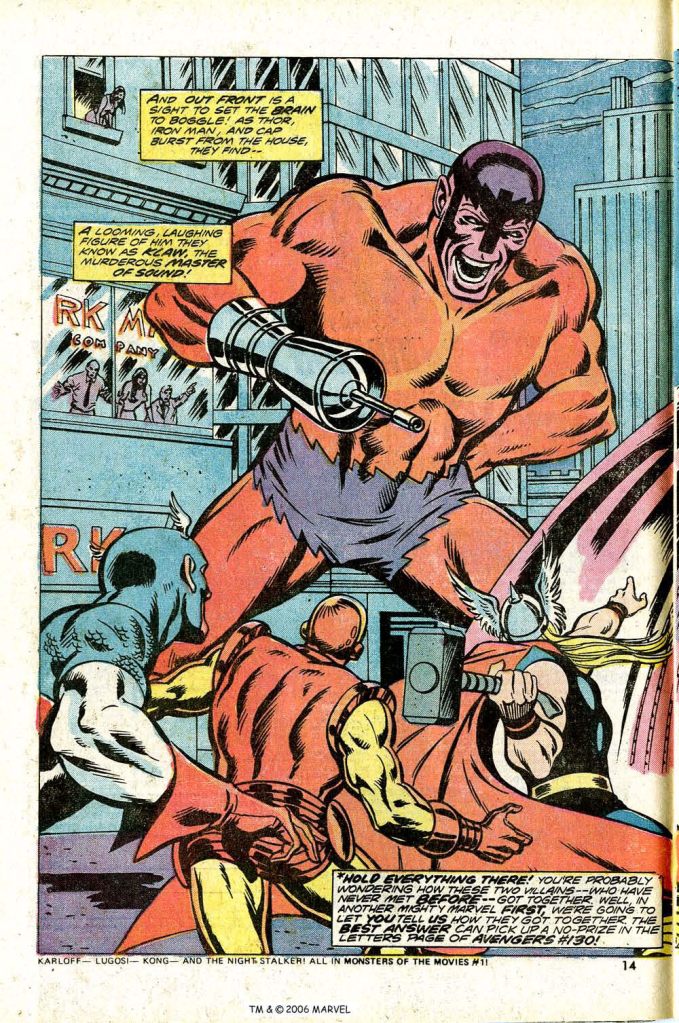
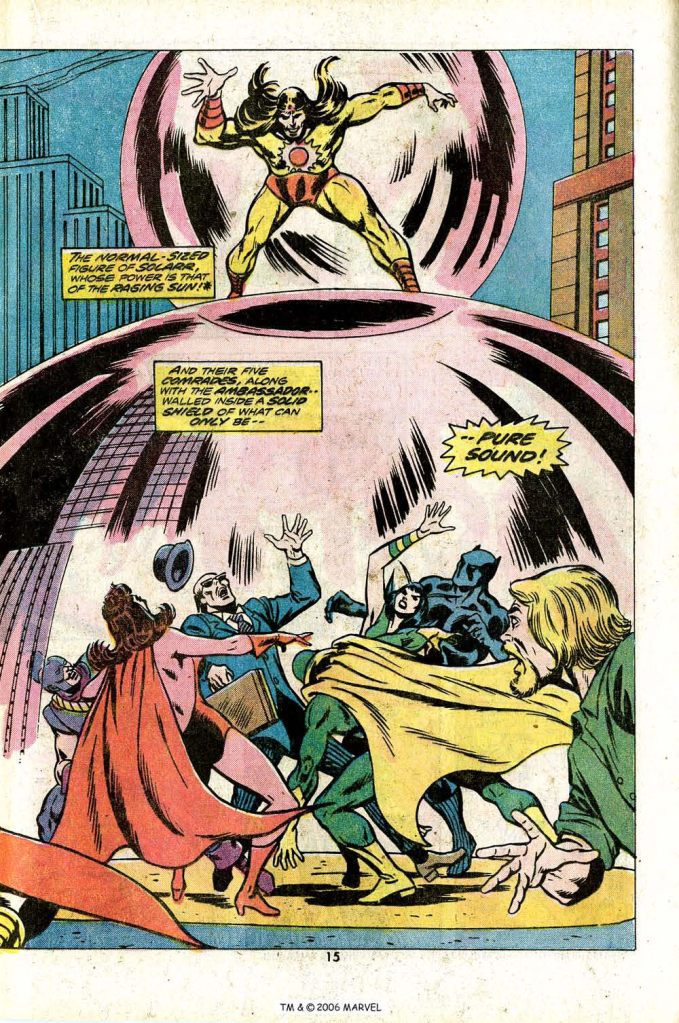
So glad to read of your praise for Dave Cockrum’s contribution to this issue and several others. I never saw an art job that Cockrum’s inking didn’t improve, whether it was over a lesser-known artist like Bob Brown here, or superstars like John Buscema (Avengers #125) or Gil Kane (John Carter #1).
LikeLiked by 1 person
Considering the depth of Bob Brown’s career, it’s painful to see him described as a lesser known artist! Fun fact: If he hadn’t passed away, he and not Byrne would have succeeded Cockrum on X-Men according to the letter page on his posthumous fill in issue of X-Men…
LikeLike
Dave Cockrum was a great penciler, a great inker, and a great character designer. He also always came across as a good guy. It’s too bad he wasn’t a faster artist. I’m definitely a fan of his work.
LikeLike
The moment I saw Black Panther featured predominantly on the cover that he would be leaving. I was not happy about that, but perhaps editorial thought he couldn’t be trying to save his kingdom in Jungle Action and running around with the Avengers (although that logic didn’t seem to apply to the equally-busy Thor, Cap, and Iron Man).
LikeLike